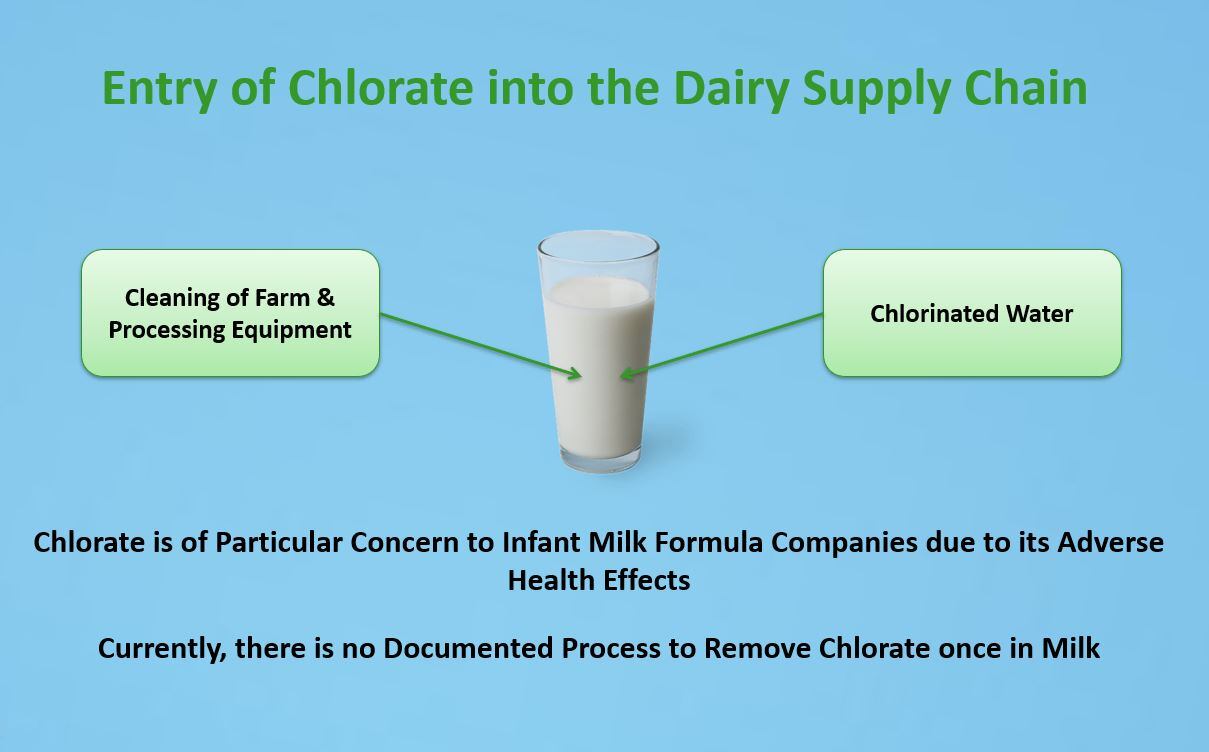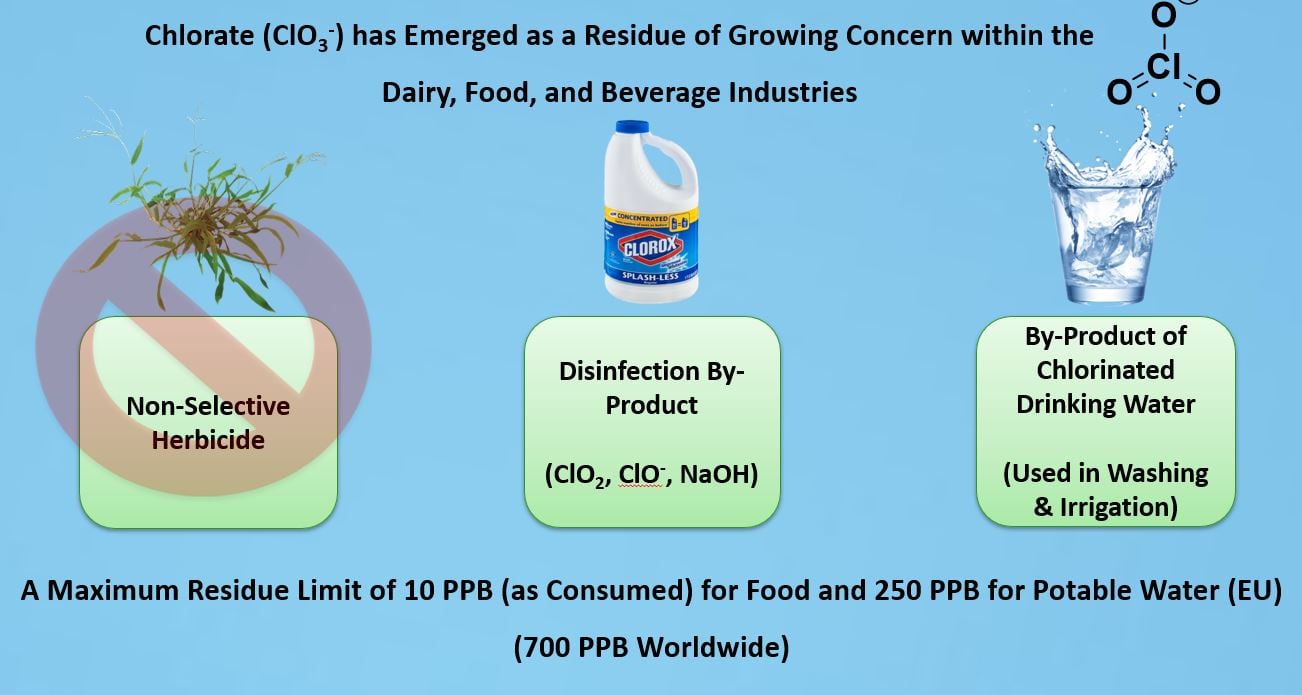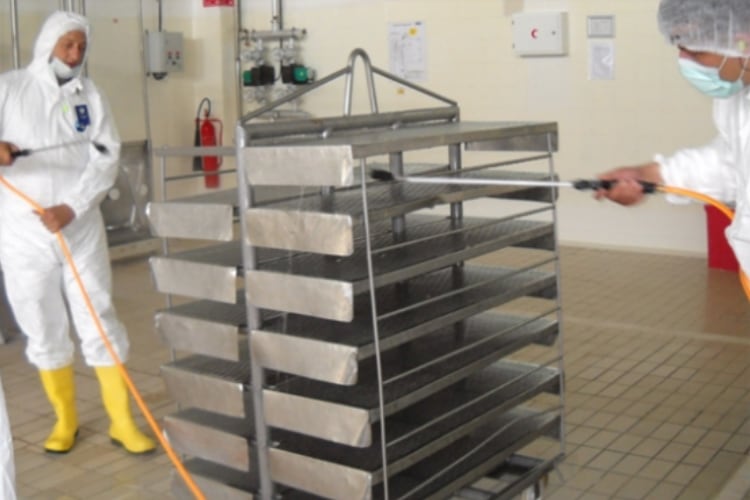The toxicological implications driving these regulations have been the focus of many research groups in recent years, with chlorate in particular highlighted as an emerging residue of concern by EFSA (European Food Safety Authority).
FSAI 2019

Speaking to William P. McCarthy, researcher and PhD student Teagasc, at FSAI (Food Safety Authority of Ireland) 2019 in Dublin last month (August 21-22), he said very little research has been done on this emerging residue in milk and dairy products but it is crucial future research addresses this deficiency, particularly as dairy products are often a major source of nutrition for some of the most vulnerable consumers within the population.
“It is vital the factors affecting oxychlorine contamination within the dairy supply chain are identified and a comprehensive risk-benefit assessment is completed for CIP procedure development within the dairy supply chain,” he said.
“It is recognized that the use of chlorine-based treatment throughout the CIP process through the use of chlorinated water and active chlorine detergents is not ideal considering the large catalog of associated DBPs.
“These drawbacks can be overcome by a better understanding of the reactions leading to their degradation and the steps needed to minimize their introduction into the dairy processing chain starting at the farm level.
“This is of particular concern with the risks of microbial contamination versus the risks associated with dietary DBP consumption which are controlled by CIP practices and its inputs.
“To ensure the safety of dairy products closer monitoring of detergents and processing water must be conducted during industrial production to minimize DBP contamination and increase consumer safety.”
Along with a team of scientists including; McCarthy, Tom O'Callaghan, Martin Danahar, David Gleeson, Christine O'Connor, Mark Fenelon and John Tobin from Teagasc and the Technological University of Dublin, the researchers have put together a paper to assess the efficiency of nanofiltration (NF) for chlorate removal in milk.
They found chlorate, has a default maximum residue level of 10ppb under regulation (EC) No.396/2005. This has led to a number of food products having to be withdrawn from food markets and destroyed due to non-adherence.
To date, there are no documented methods for the removal of chlorate from milk. Its work, using membrane separation technology, a process commonly used within the dairy industry, has been demonstrated to decrease the chlorate content of milk used as an in process milk concentration step.
Such processing has been demonstrated to be capable of removing chlorate to bring back into specification reconstituted skim milk powder and liquid milk.
Reverse Osmosis
As part of the study, two nanofiltration (NF) membranes (150-300 Da MWCO and 300-500 Da MWCO) demonstrated a reduction of 58% and 62% per unit dry matter respectively when concentrating solutions from 9% to 18% total solids, while the use of Reverse Osmosis demonstrated a twofold concentration of chlorate over the same concentration step.
“For dairy products, the entry points for chlorate lie both at the primary producer (on-farm practices) and at the processor level, which are linked to both chlorinated water usage and/or sanitation practices,” said McCarthy.
“Water usage in all aspects of dairy production remains a critical entry point of chlorate into the supply chain. It is necessary to understand how sanitation of water itself influences this risk of cross-contamination into the dairy supply chain.
“Sanitation of water with chlorine gas (Cl2), dioxide (ClO2), or hypochlorite (ClO−) remains common practice in many jurisdictions due to chlorine’s bactericidal and oxidative properties.”
Overall, the researchers found, the analysis of liquid milk, milk powders, and other dairy samples presents a number of challenges. Dairy samples contain a number of components that can interfere with analysis, such as proteins, fat, and sugars. Consequently, most analytical methods include protein precipitation steps, which involve the addition of a water-miscible organic solvent and acid.
Fat is a component that is present in whole milk, but at lower concentrations in skimmed milk, skimmed milk powders, and whey powder. Fat can be removed from milk or reconstituted samples by centrifugation, or more costly solid phase extraction steps.
The sanitation of processing equipment is of major importance across the dairy supply chain, mainly to prevent outbreaks of foodborne illnesses (FAO/WHO, 2009). In industrial food processes, effective sanitation is achieved by the implementation of a CIP program which embodies a systematic cleaning of the interior surfaces of pipelines, filters, and other equipment without the need to dismantle the equipment.
The efficiency of cleaning and sanitation of product contact surfaces is influenced by multiple factors, including the nature of contamination, microtopography of surfaces within the processing unit, straightness of passageways, and compatibility of surface agents.

Each factor must be taken into account to develop an effective CIP program.
Typically, CIP systems incorporate various rinse-and-wash cycles with water, disinfectants, and acidic solutions to achieve an effective removal of contaminating organic and inorganic materials, maintaining the integrity of process equipment.
Milk and dairy products offer highly nutritious food for microorganisms to multiply, which can lead to product spoilage. The concentration and types of microbial contamination depend on the raw material quality, the conditions under which the products were produced, and the temperature and duration of their storage.
Foodborne illness
Milk and dairy products have also been linked to foodborne illness. In the US, milk was found to be the cause of 1.1% to 1.7% of foodborne disease outbreaks with a known vehicle in the period of 1998 to 2002, with over 90% of these being caused by bacteria in raw milk.
Due to the development of a hygiene program, the quality of milk has increased significantly over time. In 1997, it was reported in Germany that raw milk had an average count of 5 × 105 colony forming units (cfu)/mL, whereas in 2002, an average count of 2×104 cfu/mL (Suhren & Reichmuth, 2003).
Cleaning of dairy equipment was once completely manual, using brushes and detergent, and it involved dismantling the equipment to access every surface. This approach was labor and time intensive and also counterproductive since contamination can be reintroduced to the system by imperfectly cleaned equipment.
These issues were solved by the introduction of CIP programs, which adapt automated cleaning systems in various parts of the processing plant to achieve the necessary cleaning and sanitation results.
Cleaning procedures are carried out by strictly following a program that is carefully designed to attain the necessary degree of cleanliness before the product is introduced. The cleaning cycle in dairy processing is composed of the following stages:
(1) Recovery of product residues through scraping, drainage, and expulsion with water or compressed air. (2) Pre-rinsing with treated water to remove loose dirt. (3) Cleaning with detergent. (4) Rinsing with clean water. (5) Sanitizing using heat or, optimally, chemical agents.
Most of the equipment used in the handling of milk and milk products is kept clean and disinfected by CIP systems, where product contact surfaces, normally of stainless steel construction, are cleaned daily.
Chlorine-based sanitizers (HOCl and ClO2) are the most commonly used sanitizers in food processing and handling applications, and they have been approved by the US Food and Drug Administration (FDA) for use as no-rinse sanitizers in food production.
Recently, cleaning protocols have been developed for dairy farm equipment without the requirement for sodium hypochlorite, reducing the risk of chlorine residues being introduced into the system (Gleeson & O’Brien, 2013). Possible routes of entry of disinfectants in dairy processes include their application for teat and skin disinfection, cleaning of milk storage tanks, and CIP treatment of milking equipment (Fischer et al., 2011). The use of chlorinated water during food processing is the main cause for the occurrence of chlorate residues in food.
Conclusion
In conclusion, McCarthy said: "The presence of chlorate in milk and dairy products can arise from the use of chlorinated water and chlorine-containing detergents for cleaning and sanitation of process equipment at both farm and processor level. Chlorate and other oxychlorine species have been associated with inhibition of iodine uptake in humans and the formation of methemoglobin, with infants and young children being a high‐risk demographic, due to their increased sensitivity to the toxicological effects of chlorate.
"Infant milk formula (IMF) plays a crucial role in early infant nutrition, with fewer than 40% of infants breastfed exclusively in developing countries, while only 13% of US and EU infants rely solely on breast milk, by the age of six months. The EU has established a default maximum residual level of 10 parts per billion for food (as consumed), with IMF manufacturers requiring compliance with specific chlorate levels in ingredients utilised in IMF.
"There is currently no known means of removing of chlorate from milk once present, meaning ingredients with high chlorate levels can have a substantial impact in complying with regulations relative to the effect on finished products. With this in mind, we set out to develop a means of chlorate removal, which is both easily implemented and accessible to the dairy industry, as a means to mitigate high chlorate levels coming from suppliers, as well as bring out of specification processed milk components back into adherence to regulatory limits set out by IMF manufacturers."
Previous work in the group surrounding the tracking of chlorate throughout the dairy processing chain indicated that membrane processing using reverse osmosis, as a water removal step before spray drying and evaporation, resulted in a notable increase in chlorate concentration in solution.
"This increase in chlorate concentration was not due to additional chlorate being added into the system (only chlorine-free detergents and reverse osmosis processing water were used), but a result of using reverse osmosis as part of the concentration step, due to chlorate being too large a molecule to partition the membrane and thus stays with the milk solids," said McCarthy.
"We noted this was a critical control step to ensure product compliance, and could mitigate the further magnification of chlorate seen during evaporation spray drying.
"In the design of this study, we focused on nanofiltration (NF) due to it having a large enough pore-size to allow similarly sized molecules (as chlorate) partition, such as iodine, while not losing more significant milk components during processing. Nanofiltration is commonly used within in the dairy industry, used for partial desalination of milk and whey, and would be cost-effective to implement for the removal of chlorate from out of specification product.
"Our observations regarding RO water indicated that chlorate would partition through the membrane due to the very low MWCO associated with these membranes. Based on our observation relative to iodine depletion during NF of whey it was hypothesised that similar behaviour would be observed for chlorate due to their similar ionic size and charge, as seen during competitive uptake by the Natrium Iodide Symporter of the thyroid.
Initial evaluations were conducted at lab-scale, investigating reverse osmosis and different NF conditions. With samples tested using an accredited method within the organisation, indicating that it was possible to remove about 60% of chlorate per unit dry matter using NF. Validation of lab-based observations has been carried out at pre-commercial pilot plant scale to assess partition of other milk components in parallel with removal of chlorate.
The researchers are now completing a comprehensive mass and energy balance relative to the use of NF, as opposed to RO, membranes during concentration of skim milk before evaporation, to fully assess its feasibility and robustness in the dairy factory. While also assessing recovery and re-use scenarios for any milk solids permeated during the initial NF concentration.
"This study highlights the potential for NF to be installed as a critical control point for liquid skim milk as part of a chlorate control strategy. In the event that a high chlorate level is present in incoming liquid milk, NF provides a degree of confidence that up to 60% of the chlorate content contained in the incoming milk will be removed. Before this study, prevention, by means of removal of chlorine from the supply chain was considered as was the only means addressing the chlorate issue, as there were no documented means of its removal from dairy systems," said McCarthy.
"The challenge surrounding implementation of this technology includes the loss of dairy solids, in addition to chlorate, which will partition through the membrane. This will be considerably higher for NF as opposed to RO; However, polishing of NF permeates with an additional NF step, albeit using a smaller MWCO, may create an opportunity for recovery of residual components (predominantly lactose and milk salts) while still providing sufficient removal of chlorate.
"Our current studies are focused on chlorate minimisation strategies at both farm and milk processing site by evaluating current use practices relative to cleaning in place strategies and the use of process water and processing aids which can contribute to the chlorate levels in finished products.
"Additionally, we are evaluating water usage and equipment stabilisation strategies in dairy factories, to minimise the risk of chlorate enrichment within the processes, particularly in thermal concentration processes and operations where there is potential for significant contact potential for of product and process water streams. In tandem we are also identifying bioremediation strategies relative to microbial species present in milk which have the potential to metabolise chlorate to safe derivates, similar to previous investigations relative to groundwater."
Source: The Application of Nanofiltration for the Removal of Chlorate from Milk
Published: October 10, 2018
Author(s): William P. McCarthy, Tom F. O'Callaghan, Martin Danaher, Christine O'Connor, Mark A. Fenelon, John T. Tobin.



